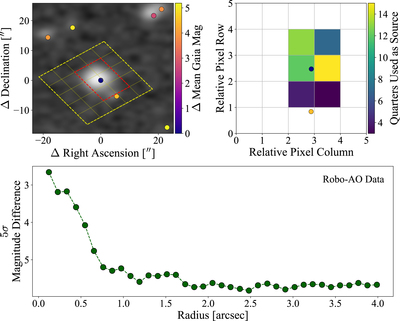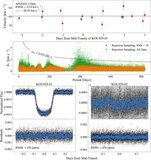Image Details

Caption: Figure 1.
Stellar background around Kepler-730. The upper left panel shows the six stars identified by Gaia within a sky-projected distance of ﹩30^{\prime\prime} ﹩ atop an image of the same region from the Second Palomar Observatory Sky Survey (POSS-II/Red). The closest star, KIC 9141752, has a sky-projected distance of ﹩6\buildrel{\prime\prime}\over{.} 57﹩. Gaia detected no other stars within the 5 × 5 pixel mask (yellow grid) used by Kepler. The Kepler aperture mask (red grid) is highlighted in the upper right panel, with each pixel colored to the number of quarters it used as a source pixel. Only Kepler-730 is contained in the aperture mask where the majority of the flux originates. The bottom panel shows the contrast curve provided by the Robo-AO survey illustrating the threshold magnitude difference to detect a stellar companion as a function of distance from Kepler-730. Robo-AO did not detect any other sources within ﹩4^{\prime\prime} ﹩ of Kepler-730.
Copyright and Terms & Conditions
© 2019. The American Astronomical Society. All rights reserved.




